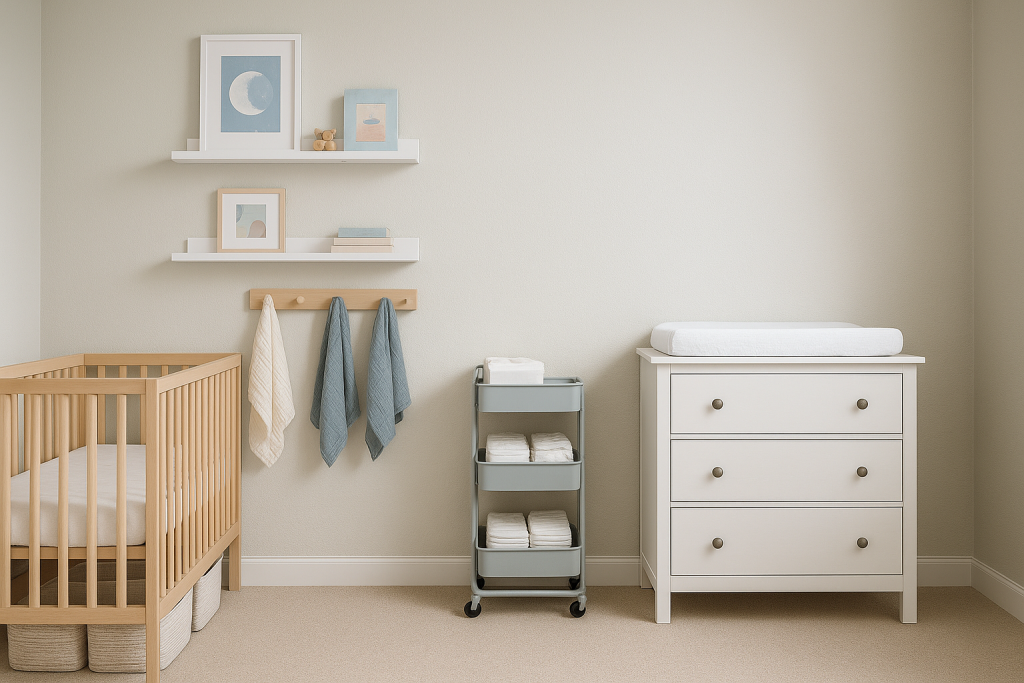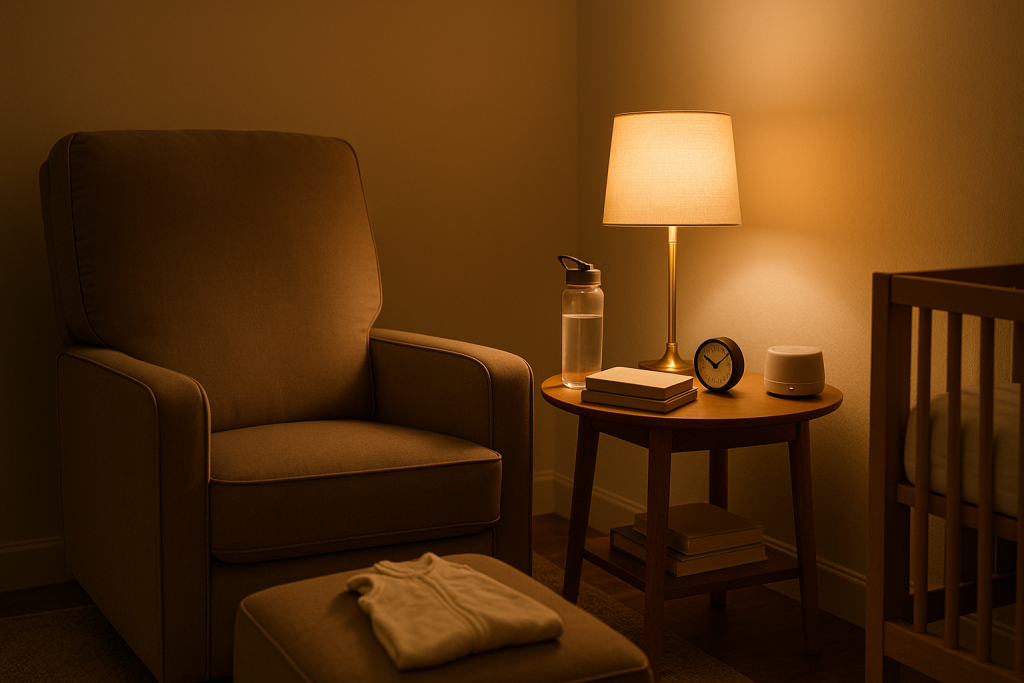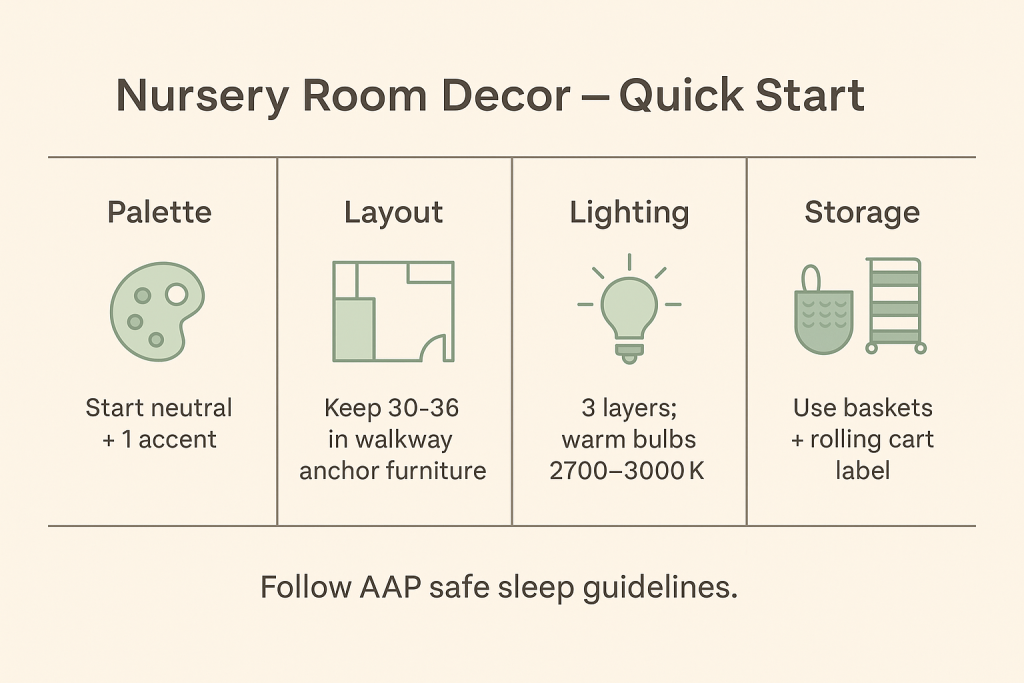Nursery Room Decor: Calm, Stylish & Safe Ideas (Guide)
We may earn a commission for purchases made using our links. Please see our disclosure for more details.
You want a nursery that feels calm at 2 a.m., looks beautiful in daylight, and still makes sense when your little one becomes a curious toddler. That’s a lot to ask from one room—but totally doable. In this friendly guide to nursery room decor, you’ll learn how to choose colors, plan layouts (even for tiny spaces), layer lighting, and pick pieces that grow with your baby—without sacrificing your style.
Affiliate note: I may earn from qualifying purchases at no extra cost to you.
Start with your vision (and a mood you’ll love at 2 a.m.)
Before you buy anything, picture how you want the room to feel. Cozy and cocoon-like? Airy and minimal? Playful with pops of color? Write down 3–5 words (e.g., “soft,” “warm neutrals,” “nature-inspired”) and let those drive every decision. This keeps nursery room decor cohesive and helps you avoid random impulse buys.
Try this:
- Save 8–10 inspiration images (max!) and note why you love each one.
- Ask yourself: Will I still love this in two years? If yes, it’s a keeper.
- Choose one accent: wood tone, metal finish, or color—then repeat it.
Choose a calm, flexible color palette
Soft neutrals (warm white, mushroom, oatmeal, greige) make the space soothing and easy to update. Add accent colors (sage, dusty blue, terracotta, blush) with textiles and nursery wall art. Neutrals also play nicely with hand-me-down toys and gifted blankets.
LSI to weave naturally: baby nursery ideas, gender-neutral nursery, neutral color palette, nursery wall art.
Safe paint & materials matter
If you’re repainting, look for low- or zero-VOC paints and let the room air out well. Stick with furniture finishes that are non-toxic and baby-safe. You’ll breathe easier (literally), and delicate noses will, too.
Quick checks:
- Low/zero-VOC paint
- Third-party certifications when possible (e.g., GREENGUARD Gold on furniture)
- Solid construction (no wobbles or gaps)

Layouts for small nursery rooms
Design for flow: door → changing zone → crib → glider/reading nook. Keep pathways clear for midnight diaper runs. If space is tight, a narrow dresser with a changing pad on top doubles as a changing table.
Small nursery ideas:
- Use vertical space: wall shelves, peg rails, over-door storage.
- Floating shelves for books near the glider.
- Under-crib bins for out-of-season clothes.
- Round rugs soften tight corners and make rooms feel bigger.
Crib, dresser & changing table: the core furniture
Pick the crib first (it sets the style and footprint), then a dresser/changer, then a comfortable seat. Convertible cribs and dressers that outlast the diaper era save money and reduce waste. If you’re going gender-neutral nursery, choose timeless silhouettes and change the vibe with prints, pillows, and wall decals.
Practical details:
- Four mattress heights are helpful the first year.
- Dresser drawers glide smoothly with one hand (you’ll often have a baby in the other).
- Anchor tall furniture to the wall. Always.
A cozy reading nook that grows with your child
Add a supportive glider or rocker, side table, dimmable lamp, and a soft throw. Keep 10–15 board books within reach. Later, swap the glider for a small accent chair or floor cushions and add a low bookshelf for independent browsing.
Reader-friendly add-ons:
- Clip-on light for late feeds
- Lidded basket for swaddles and burp cloths
- A small speaker for lullabies (more on sound later)
Layered nursery lighting for sleepy nights
Overhead light + dimmable lamp + night light = flexible. Warm (2700K–3000K) bulbs keep the vibe restful. A tiny night light by the changing area lets you do diapers without a light blast to the eyes.
Tip: Install a dimmer switch. It’s a ten-minute upgrade that pays off nightly.
Soft textiles & crib bedding basics
For safe sleep, keep the crib simple: a firm mattress and a tight-fitting sheet. Add your texture and color with a throw over the chair, a quilt on a blanket ladder (for décor only), and a cushy rug underfoot.
Crib bedding checklist:
- 2–3 fitted crib sheets
- 1–2 waterproof mattress protectors
- Breathable fabrics (cotton, bamboo) for swaddles/sleep sacks

Nursery wall art & gallery moments
Frame family photos, prints of favorite animals, or travel mementos to tell your story. If you rent, try peel-and-stick wallpaper on one wall or a large removable decal above the dresser. Hang frames securely and out of reach of the crib.
Ideas you’ll love:
- Soft watercolor animal prints
- A simple wooden name sign
- Shadow boxes for hospital bracelets & tiny socks
Storage that actually works (baskets, carts, cubes)
Think “zones”: diapering, feeding, laundry, and toys. Use lidded bins for things you don’t want to see every day (pump parts, backup wipes), and open baskets for blankets and toys. A rolling cart makes a perfect night-shift station.
Changing table organization:
- Top drawer: diapers, wipes, cream
- Second: onesies & PJs
- Third: swaddles, sleep sacks, extra sheets
Rugs & playmats for comfort and play
A plush rug or foam playmat softens hardwood floors and makes tummy time nicer. Choose easy-to-clean materials. Round or oval rugs visually open small rooms; patterned options hide tiny spills and crumbs until you can grab the vacuum.
Blackout curtains & better sleep routines
Darkness helps signal bedtime and naps, especially for light-sensitive babies. Blackout curtains layered over blinds give you more control—think “midday nap” without a fight. Use a holdback to let in morning light when you’re ready.
Pro move: Hang curtains high and wide to make windows look larger.
Montessori-inspired touches & open shelves
Low shelves, a floor mirror (for supervised play), and a small basket of rotating toys encourage independence. Keep just a few items out at a time to minimize overwhelm—for you and for baby.
Accent wall: wallpaper, decals, or paint
If you want personality without committing the entire room, decorate one wall. Soft botanicals, starry skies, or modern geometrics create a beautiful focal point behind the dresser or reading nook. Bonus: It’s easy to refresh later.
🔹 Affiliate Product Picks: 5 Nursery Room Decor Essentials
Below are five parent-fave items that blend form and function for nursery room decor. I chose pieces that are versatile, widely loved, and easy to integrate into most styles.
1) Hatch Rest 2nd Gen – Sound Machine & Night Light
Create wind-down routines with customizable white noise, colors, and schedules you can control from your phone. It’s a tidy, modern glow that keeps night feeds low-stress.
Features: App-controlled routines, white noise library, night light, time-to-rise.
Pros: Clean design, consistent sound, grows from newborn to toddler.
Cons: Some premium content requires subscription; keep volume modest.
Best for: Families who want gentle, repeatable bedtime rituals.
Review snapshot: Frequently praised for easy routines; occasional gripes about locking advanced features behind a subscription.
Warranty: Hatch lists a one-year limited warranty.

2) RoomMates Peel-and-Stick Wallpaper (Nursery Patterns)
Instant accent wall without paste or mess, and it’s removable—perfect for renters or style shifters.
Features: Peel & stick, removable/repositionable; roll sizes vary by pattern (e.g., 18″ × 18.86′ ≈ 28.3 sq ft; some patterns 20.5″ × 18′ ≈ 30.75 sq ft).
Pros: Low commitment, renter-friendly, tons of nursery designs.
Cons: Not designed for textured walls; surface must be clean and flat.
Best for: Fast transformation and photo-ready backdrops.
Review snapshot: Parents love the look and easy install; alignment takes patience on larger patterns.

3) NICETOWN 100% Blackout Curtains
Blackout panels with a sewn-in liner to darken the room for naps and early bedtimes.
Features: 2 panels, thermal insulated, 100% blackout liner on select models; multiple lengths and colors.
Pros: Excellent light control, helps with naps and early bedtimes.
Cons: May arrive wrinkled—steam or tumble on low; warranty varies by listing.
Best for: Light-sensitive sleepers; rooms with streetlights.
See options: NICETOWN 100% Blackout Window Curtain Panels (various sizes/colors).

4) Babyletto Hudson 3-in-1 Convertible Crib
A modern, GREENGUARD Gold-certified crib that converts to a toddler bed and daybed, so it grows with your child.
Features: 3-in-1 conversion (toddler rail included on many listings), 4 mattress heights, non-toxic finish, GREENGUARD Gold certified.
Pros: Long lifespan, clean design, widely available parts.
Cons: Assembly takes a bit; measure doorways before moving.
Best for: Design-forward parents who want a safer, certified option.
Warranty: Babyletto provides a 1-year limited warranty.

5) Parker Baby Diaper Caddy (Felt Organizer)
Corral diapers, wipes, and creams in a soft felt tote you can carry from room to room—or stash beside the glider.
Features: Removable dividers, outer pockets, multiple sizes/colors.
Pros: Portable, versatile, looks tidy on open shelves.
Cons: Felt sides are flexible; not for heavy bottles without support.
Best for: Night-shift diapering, small spaces, multi-level homes.
See it: Parker Baby Diaper Caddy – Nursery Storage Bin & Car Organizer.

Quick Comparison
| Model | Key Spec(s) | Warranty | Approx Price/Tier | Best For |
| Hatch Rest 2nd Gen | App-controlled routines; night light + white noise | 1-year limited (Hatch) | $$ | Bedtime routines & gentle wakings |
| RoomMates Peel-and-Stick Wallpaper | Removable; roll ~18″×18.86′ or 20.5″×18′ | N/A (product dependent) | $–$$ | Fast accent wall; renters |
| NICETOWN 100% Blackout Curtains | Sewn-in blackout liner (select models) | See seller listing | $ | Midday naps; streetlight control |
| Babyletto Hudson 3-in-1 Crib | GREENGUARD Gold; 4 mattress heights | 1-year limited (Babyletto) | $$$ | Long-term value; modern style |
| Parker Baby Diaper Caddy | Felt tote with dividers & pockets | Not specified (listing dependent) | $ | Mobile changing setup; small spaces |

🧪 Research-Backed Insights: Why Design Choices Matter
Thoughtful nursery room decor isn’t just pretty—it supports safer sleep and healthier air.
1) Keep sleep environments simple and safe.
The American Academy of Pediatrics’ 2022 guidance recommends a firm, flat sleep surface, placing baby on the back for every sleep, and keeping soft items (pillows, quilts, bumpers) out of the crib. Following these basics reduces the risk of sleep-related infant deaths.
2) Mind the sound machine volume and distance.
A 2014 Pediatrics study measured popular infant sleep machines and found some could exceed recommended noise limits at close range. Keep any device at least several feet from the crib and under hospital nursery-level volumes (~50 dBA).
3) Choose low-VOC paints and ventilate.
The U.S. EPA notes indoor VOC concentrations can be higher than outdoors, and some VOCs have short- and long-term health effects. Low- or zero-VOC paint and good ventilation help you reduce exposure while you decorate.
Related reading for small spaces: if you’re working with a compact room or rental, these ideas for space-savvy wall decor can help you think vertically and temporarily (great for nurseries that share walls with another room).
FAQs (quick, practical answers)
How do I plan a nursery layout in a tiny room?
Start with the crib wall and a dresser-as-changer opposite it. Use vertical storage (shelves, peg rails), under-crib bins, and a small glider or a cushioned accent chair.
What’s the safest way to decorate over the crib?
Keep the wall bare or use lightweight decals. Hang framed art over the dresser or reading nook instead, with secure hardware and out of reach.
Do I really need blackout curtains?
If naps are a struggle or you live with streetlights, yes—blackout panels help. Combine with a consistent routine (dim lights, brief story, white noise) for smoother sleep.
Which paint finish works best?
Choose scrubbable matte or eggshell for walls (kid-friendly cleaning) and semi-gloss for trim. Look for low/zero-VOC options and ventilate while painting.
How do I keep the room calm but not boring?
Layer textures (woven baskets, knit throws, soft rugs), add one accent wall (peel-and-stick wallpaper), and rotate a few colorful accessories like pillows or art prints.
Conclusion
Designing nursery room decor is part practical, part magical. Lead with a soothing palette, safe materials, and a layout that works half-asleep. Then add the personal touches—books you love, a gentle glow, a soft rug that makes early mornings kinder. You’ve got this. And when your style evolves (because it will), these choices make it easy to refresh without starting from scratch.




